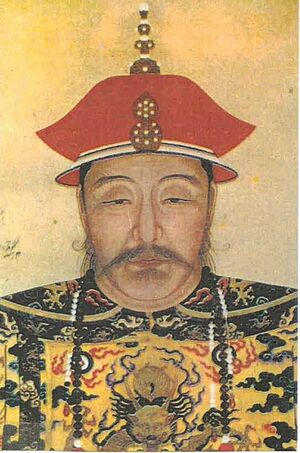Taizu Emperor facts for kids
Nurhaci (born in 1559, died in 1626) was a very important leader. He was the founder of the Qing Dynasty, a powerful ruling family in China. His full name was Aisin Gioro Nurhaci. He was a Manchu person and even created the Manchu alphabet, which is the writing system for the Manchu language.
Contents
Early Life and Rise to Power
In 1580, Nurhaci became a general for the Ming Dynasty. This was a big step for him. He worked hard to bring together many different Manchu tribes. He also created a special military and social system called the Eight Banners. This system helped organize his people and armies very well.
Founding the Jin Dynasty
In 1616, Nurhaci made a big declaration. He called himself Khan, which means King. He then started his own ruling family, the Jin Dynasty, in a place called Liao Ling. This was a challenge to the existing Ming Dynasty.
Challenging the Ming Dynasty
In 1618, Nurhaci wanted to encourage people to join him against the Ming Dynasty. He wrote a document called the Seven Great Vexations. This paper listed his reasons for opposing the Ming rulers and shared them with everyone.
From 1618 to 1622, Nurhaci led his armies in battles against the Ming Dynasty. He was very successful, taking control of 70 cities in the northeastern part of China. After many fights, he moved his capital city to Liao Yang.
In 1622, Nurhaci's armies continued their victories by capturing the city of Guang Ning.
Final Battle and Legacy
In 1626, Nurhaci led his soldiers to attack the city of Ning Yuan. During this battle, he was injured by a cannon. Sadly, he died two days later in a small town called De-A Man. Nurhaci's actions laid the groundwork for the powerful Qing Dynasty, which would rule China for many years.


